

Values scales. Values scales are psychological inventories used to determine the values that people endorse in their lives.

They facilitate the understanding of both work and general values that individuals uphold. In addition, they assess the importance of each value in people’s lives and how the individual strives toward fulfillment through work and other life roles, such as parenting.[1] Most scales have been normalized and can therefore be used cross-culturally for vocational, marketing, and counseling purposes, yielding unbiased results.[2] Values scales are used by psychologists, political scientists, economists, and others interested in defining values, determining what people value, and evaluating the ultimate function or purpose of values.[3] Development[edit] Values scales were first developed by an international group of psychologists whose goal was to create a unique self-report instrument that measured intrinsic and extrinsic values for use in the lab and in the clinic.
Gordon Allport. Gordon Willard Allport (November 11, 1897 – October 9, 1967) was an American psychologist.
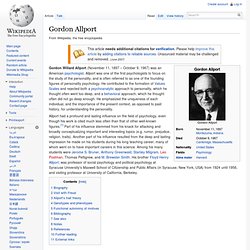
Allport was one of the first psychologists to focus on the study of the personality, and is often referred to as one of the founding figures of personality psychology. He contributed to the formation of Values Scales and rejected both a psychoanalytic approach to personality, which he thought often went too deep, and a behavioral approach, which he thought often did not go deep enough. He emphasized the uniqueness of each individual, and the importance of the present context, as opposed to past history, for understanding the personality. Allport had a profound and lasting influence on the field of psychology, even though his work is cited much less often than that of other well-known figures.[1] Part of his influence stemmed from his knack for attacking and broadly conceptualizing important and interesting topics (e.g. rumor, prejudice, religion, traits).
Biography[edit] Gordon W. 1. 2. 3. Eysenck Personality Questionnaire. In psychology, Eysenck Personality Questionnaire (EPQ) is a questionnaire to assess the personality traits of a person.
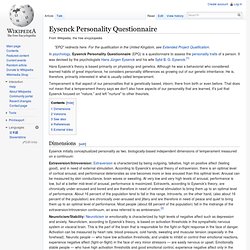
It was devised by the psychologists Hans Jürgen Eysenck and his wife Sybil B. G. Eysenck.[1] Hans Eysenck's theory is based primarily on physiology and genetics. Hans Eysenck. Hans Jürgen Eysenck (4 March 1916 – 4 September 1997) was a psychologist born in Germany, who spent his professional career in Great Britain.
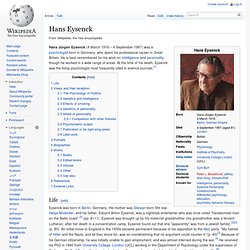
He is best remembered for his work on intelligence and personality, though he worked in a wide range of areas. At the time of his death, Eysenck was the living psychologist most frequently cited in science journals.[1] Life[edit] Eysenck was born in Berlin, Germany. His mother was Silesian-born film star Helga Molander, and his father, Eduard Anton Eysenck, was a nightclub entertainer who was once voted "handsomest man on the Baltic coast".[2] (pp. 8–11).
16 Personality Factors. The Sixteen Personality Factor Questionnaire (or 16PF),[1] is a multiple-choice personality questionnaire which was developed over several decades of research by Raymond B.
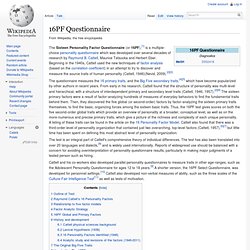
16PF Questionnaire. Raymond Cattell. As a psychologist, Cattell was rigorously devoted to the scientific method.
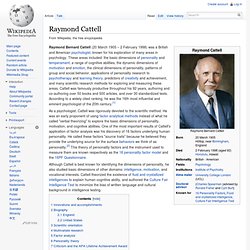
He was an early proponent of using factor analytical methods instead of what he called "verbal theorizing" to explore the basic dimensions of personality, motivation, and cognitive abilities. One of the most important results of Cattell's application of factor analysis was his discovery of 16 factors underlying human personality. He called these factors "source traits" because he believed they provide the underlying source for the surface behaviors we think of as personality.[2] This theory of personality factors and the instrument used to measure them are known respectively as the 16 personality factor model and the 16PF Questionnaire.
Big Five personality traits. In psychology, the Big Five personality traits are five broad domains or dimensions of personality that are used to describe human personality.

The theory based on the Big Five factors is called the five-factor model (FFM).[1] The five factors are openness, conscientiousness, extraversion, agreeableness, and neuroticism. Acronyms commonly used to refer to the five traits collectively are OCEAN, NEOAC, or CANOE. Beneath each global factor, a cluster of correlated and more specific primary factors are found; for example, extraversion includes such related qualities as gregariousness, assertiveness, excitement seeking, warmth, activity, and positive emotions.[2]:24 The Big Five model is able to account for different traits in personality without overlapping. Empirical research has shown that the Big Five personality traits show consistency in interviews, self-descriptions and observations. §Five factors[edit] Openness to experience: (inventive/curious vs. consistent/cautious). Lewis Goldberg. Lewis R.
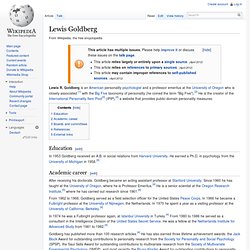
Goldberg is an American personality psychologist and a professor emeritus at the University of Oregon who is closely associated [1] with the Big Five taxonomy of personality (he coined the term "Big Five").[2] He is the creator of the International Personality Item Pool[3] (IPIP),[4] a website that provides public-domain personality measures. Education[edit] In 1953 Goldberg received an A.B. in social relations from Harvard University. He earned a Ph.D. in psychology from the University of Michigan in 1958.[4] Academic career[edit] After receiving his doctorate, Goldberg became an acting assistant professor at Stanford University. From 1962 to 1966, Goldberg served as a field selection officer for the United States Peace Corps. In 1974 he was a Fulbright professor again, at Istanbul University in Turkey.[4] From 1980 to 1986 he served as a consultant in the Intelligence Division of the United States Secret Service.